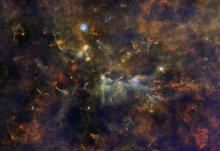Vulpecula [1]
Vulpecula, the fox, is a faint constellation. Unless you live away from city lights, you might not see any of its stars.
But that may not always be the case. It’s giving birth to some monster stars. When the “cocoon” around them clears away, some of the stars should be easy targets. And even before then, some of them will explode and briefly shine through the haze. Of course, you’ll have to wait a bit — it’ll take millions of years to play out.
The “monster” stars are part of the Vulpecula OB1 association. It’s a vast complex of stars, plus gas and dust that are forming more stars.
The association is named for its abundance of “O” and “B” stars. They’re the biggest, heaviest, and brightest of all stars. They can be dozens of times the mass of the Sun, and hundreds of thousands of times brighter.
We can’t see any of them with our eyes alone, though. The complex is about 8,000 light-years away, and the stars are still enveloped by gas and dust. Over time, that material will either collapse to form more stars, or it’ll be blown away. That will expose the stars to view.
Many of the stars will explode as supernovas. They’ll leave behind tiny, dense corpses — neutron stars or black holes. In fact, some stars in Vulpecula already have, and we’ll talk about them tomorrow.
The fox is in the northeast at dawn, to the right of bright Cygnus, the swan. But you need dark skies to see any of the fox’s stars — at least for now.
Script by Damond Benningfield
Keywords:
- Nebulae [3]
- Starbirth [4]
- Vulpecula, the Fox [5]


